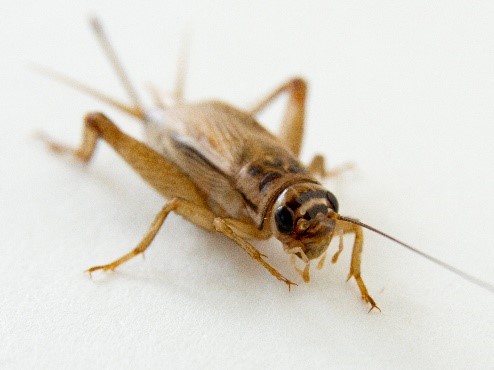The most common insect species chosen to breed for live foods are mealworms, crickets and cockroaches. Below we discuss the advantages and disadvantages of breeding each of these species.
Crickets
Click Here to Breed Crickets
Advantages
- Due to their jumping habit, crickets are often more effective at stimulating natural hunting behaviour than cockroaches or mealworms.
- Some animals are fussy eaters and will only eat crickets, while refusing other live foods.
- Crickets will generally be more active and move around the container, making them more available to be taken by animals.
- Generally don’t have the “yuck” factor associated with cockroaches
- Have a quick start up time, only requiring 6 to have an established colony.
- Unable to climb many smooth surfaces (unlike cockroaches) and are consequently easier to manage and contain. This results in fewer escapees.
- Prolific breeders that have a quick breeding lifecycle and fast production rate. A breeding colony can generally be set up within 6 weeks.
Disadvantages
- For commercial production (batch system) require additional maintenance (spraying and set up of breeding trays).
- Our “Zega Substrate Breeding System” has a similar maintenance requirement as cockroaches.
- Are not as robust as cockroaches and generally require better and more consistent management.
- Have a relatively short shelf life, living for around 2-3 months.
- Generally require higher quality wet foods (no fermenting or soggy foods)
- Can be difficult to separate (grade) old large crickets which are close to dying and younger adult crickets which can be used for sale (when using a breeding method which has mixed aged groups in a single container)
- Are not social, and will canonicalize if housed in high densities where proper management strategies are not in place.
Mealworms
Click Here to Breed Mealworms
Advantages
- Produce the most amount of insects by weight per given area.
- Mealworms can be placed into a bowl without jumping or flying away. This makes them a popular choice with wildlife rescue groups and reptile hobbyists.
- Contain high amounts of fat which is good for rehabilitating animals that are underweight (ie wildlife rescue).
- Can be placed in the fridge for extended periods for longer shelf life.
Disadvantages
- Wet food can only be provided manually so it can be labor intensive (adding and removing food).
- Relatively high maintenance requirements in terms of adding and placing food, removing frass and separating age groups. The separating age groups is relatively automated in our low small scale mealworm system, however for commercial operations age groups are separated for increased productivity.
- Dry food is most commonly brans which need to be purchased. Some farms use waste material however this is uncommon.
- Yellow mealworms are susceptible to low productivity and mortality of pupae/beetles in temperatures above 28 degrees. This reduces productivity in warmer climates. This can be overcome using the giant mealworm which likes higher temperatures. See Choosing a Mealworm Species for more detail.
Cockroaches
Click Here to Breed Cockroaches
Advantages
- Are more robust than crickets and if neglected they are more likely to survive.
- Less maintenance requirements for commercial production (i.e. no breeding trays required).
- Can be fed with a wider range of foods and of a lower quality than crickets (can tolerate fermenting and soggy foods).
- Are long lived, living for many months or years depending on the species.
- Very productive.
- Liked by most insectivorous animals.
- Are social, able to be housed in high densities without significant cannibalism.
Disadvantages
- Cockroaches quickly scuttle under cover and out of reach from your animal.
- Cockroaches are able to scale many smooth surfaces and are more difficult to contain and manage.
- Without proper management, they can escape from the breeding containers. They can then establish themselves in a house.
- Some people have a “yuck” factor associated with keeping cockroaches.
- A breeding colony can take 6 months or more to establish.
- Without proper management, can smell.





